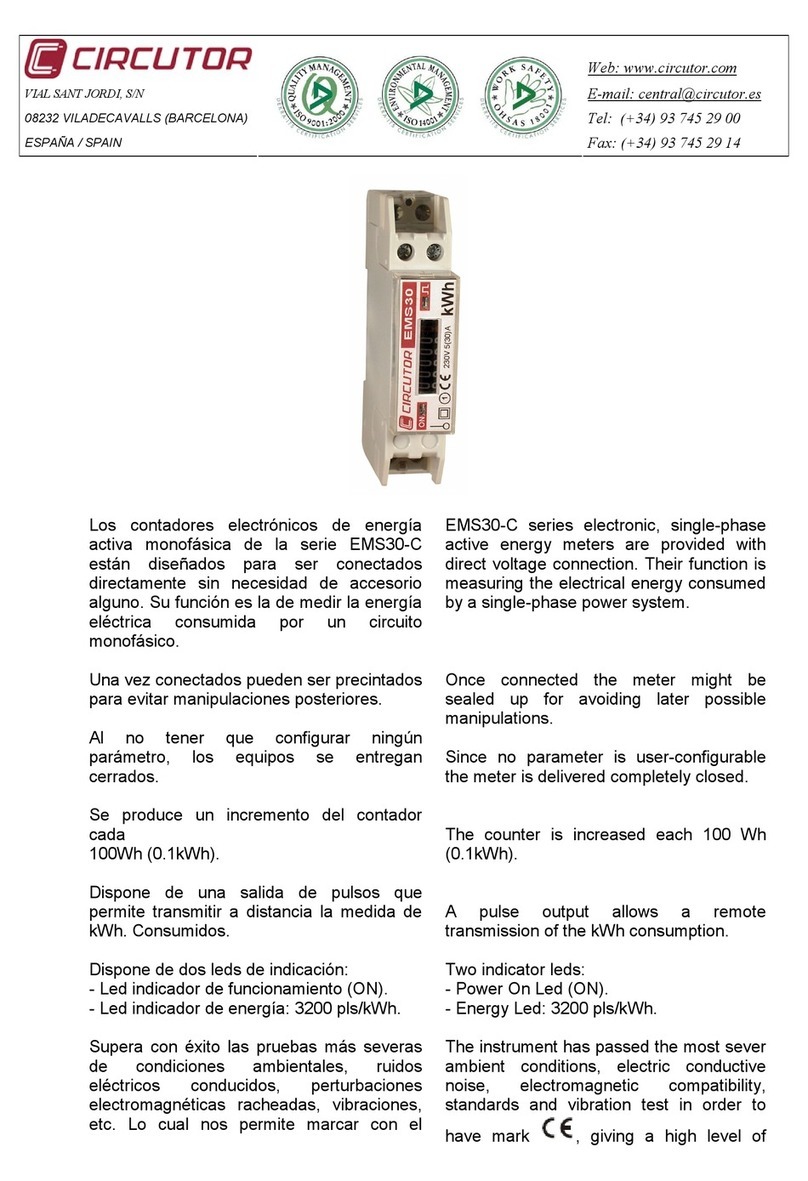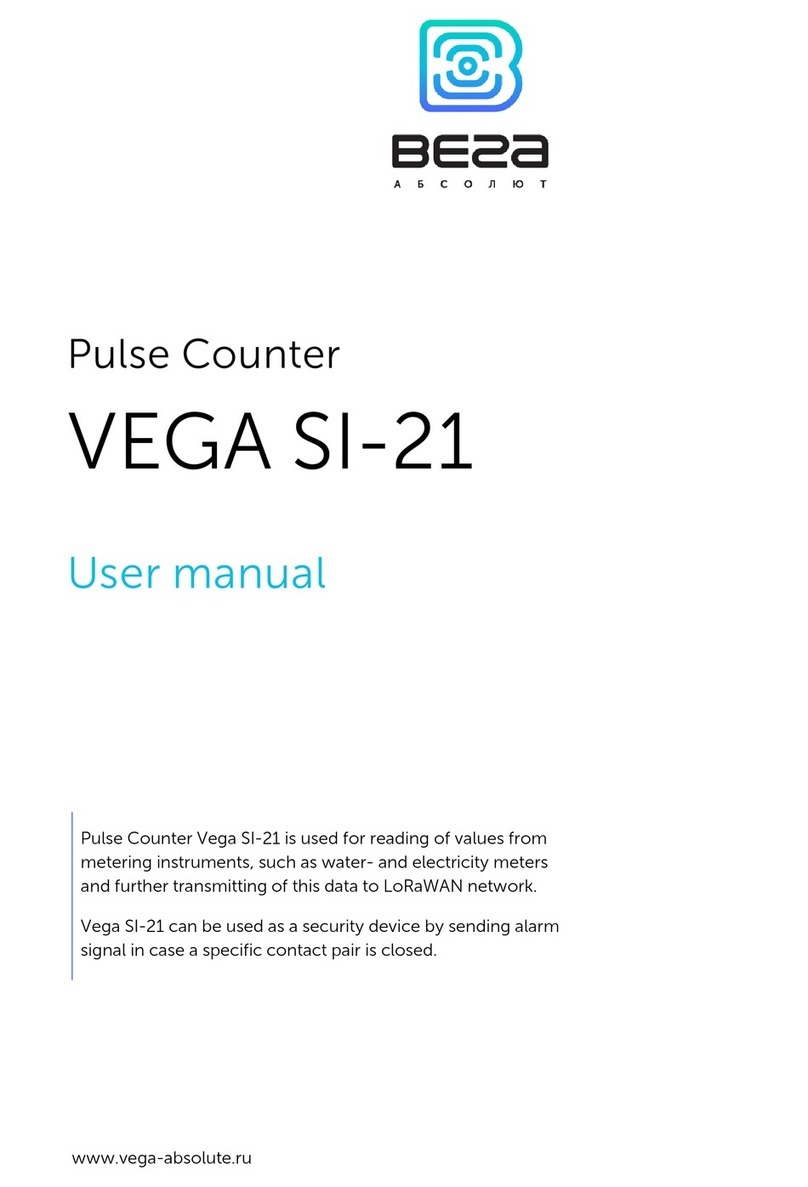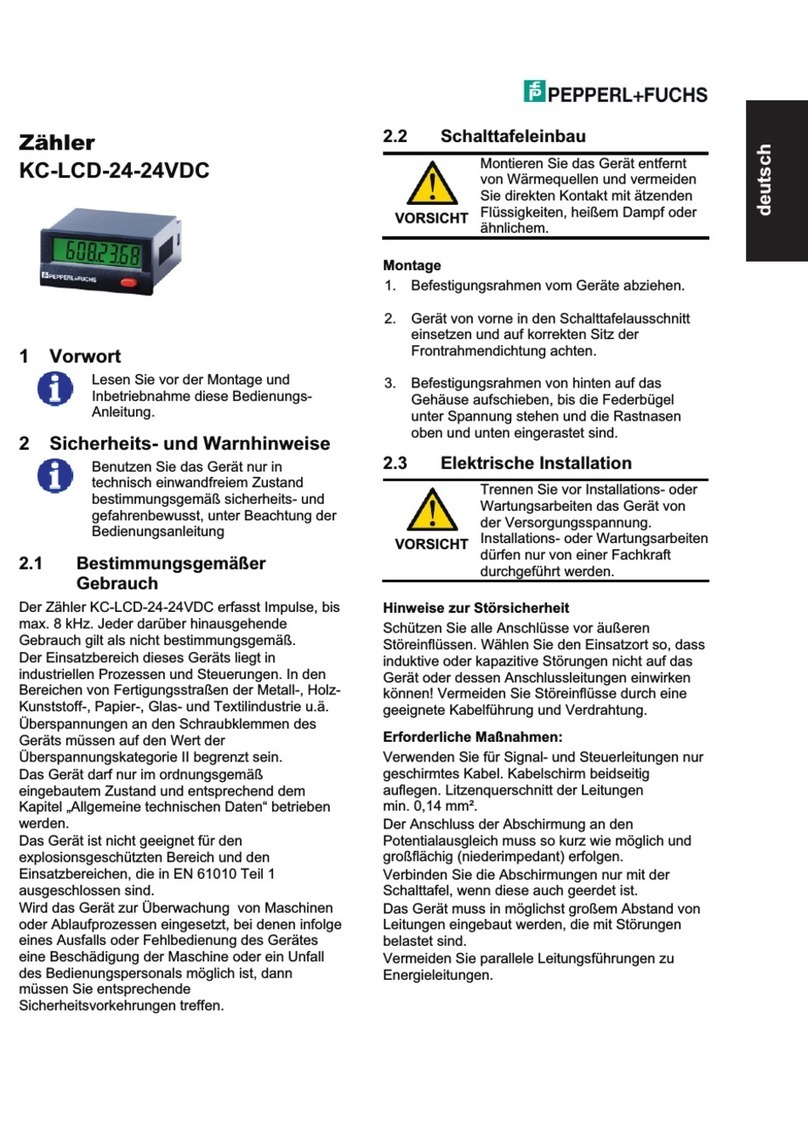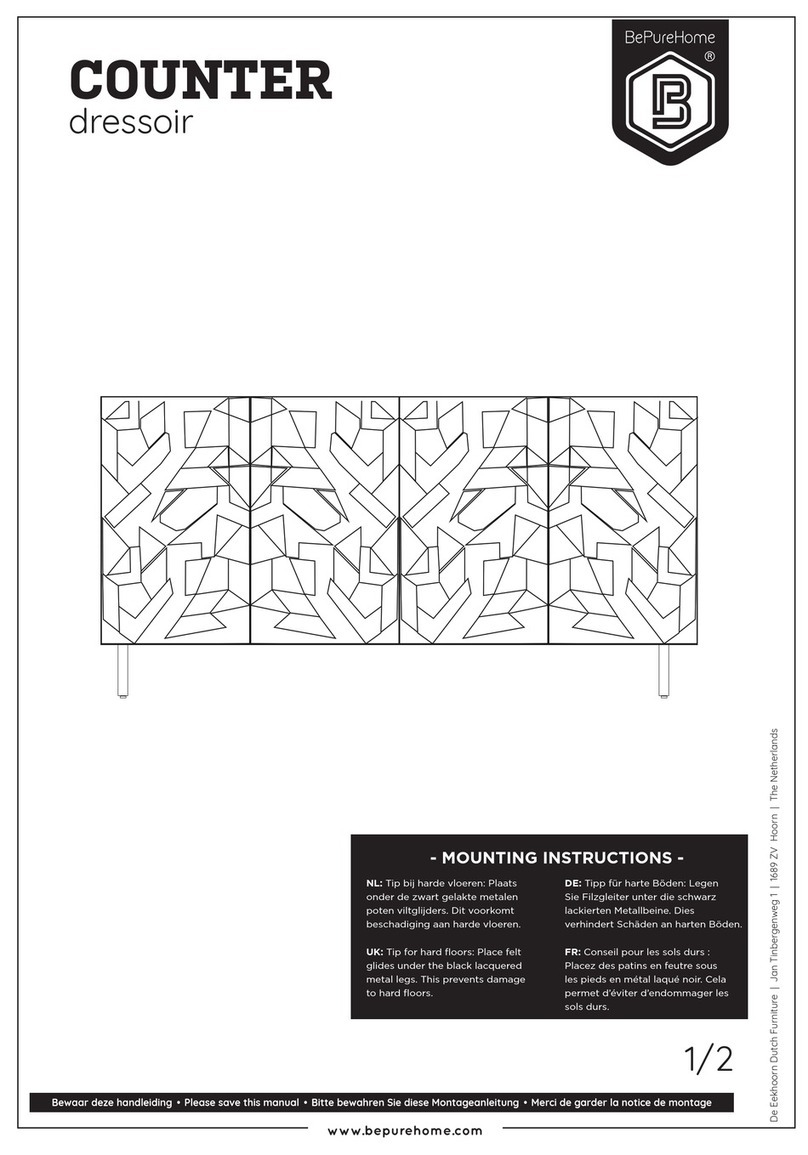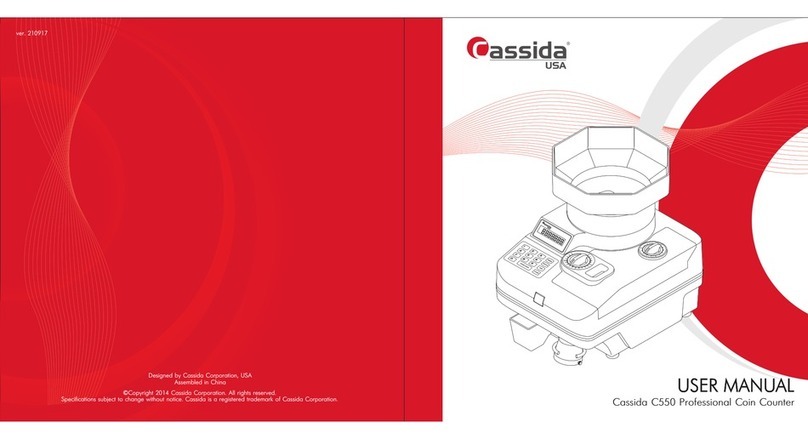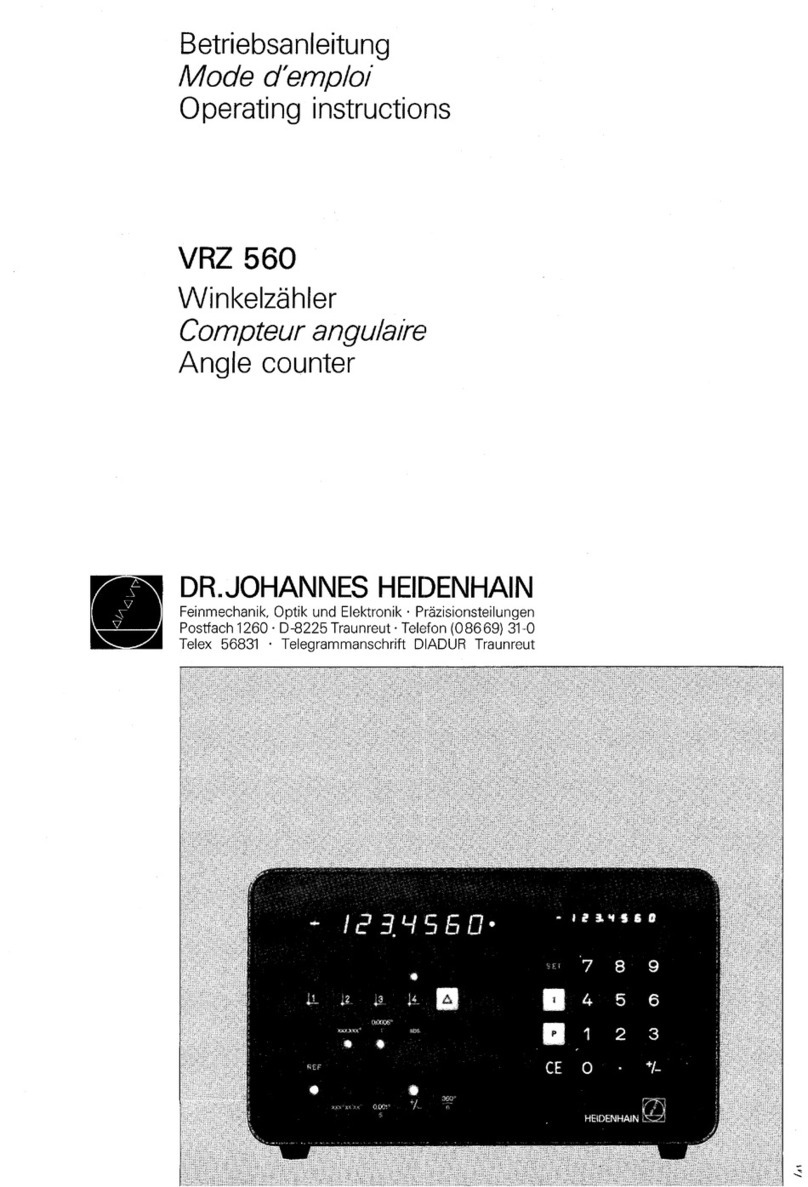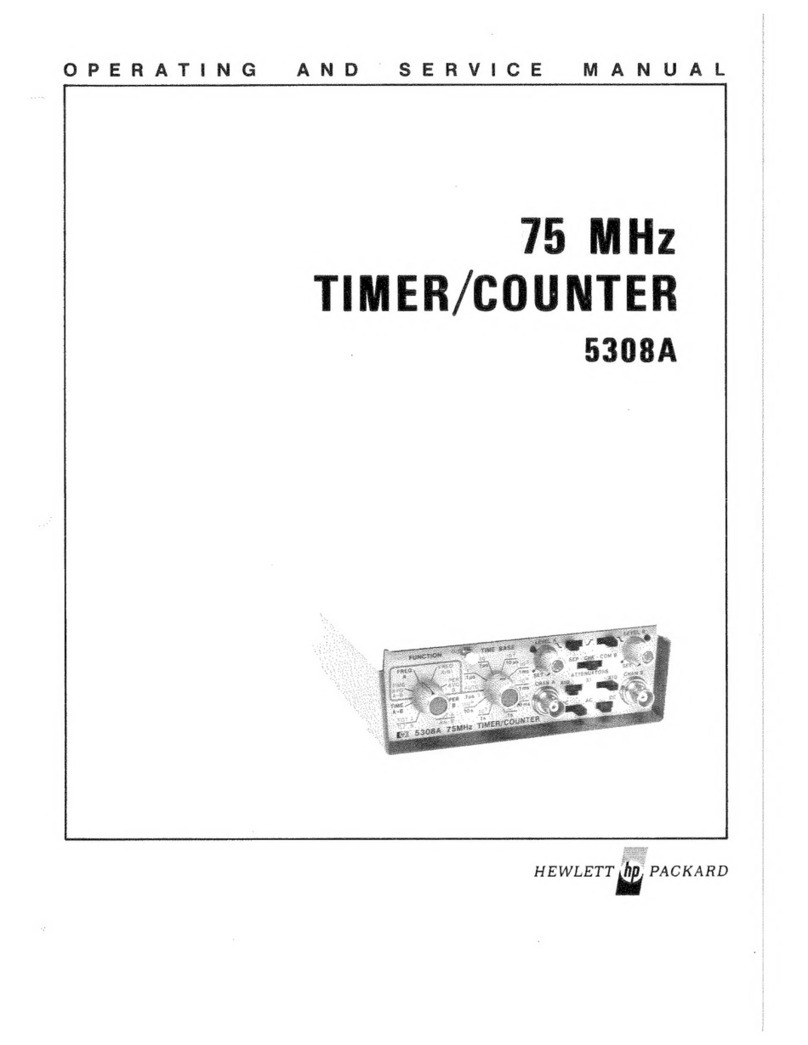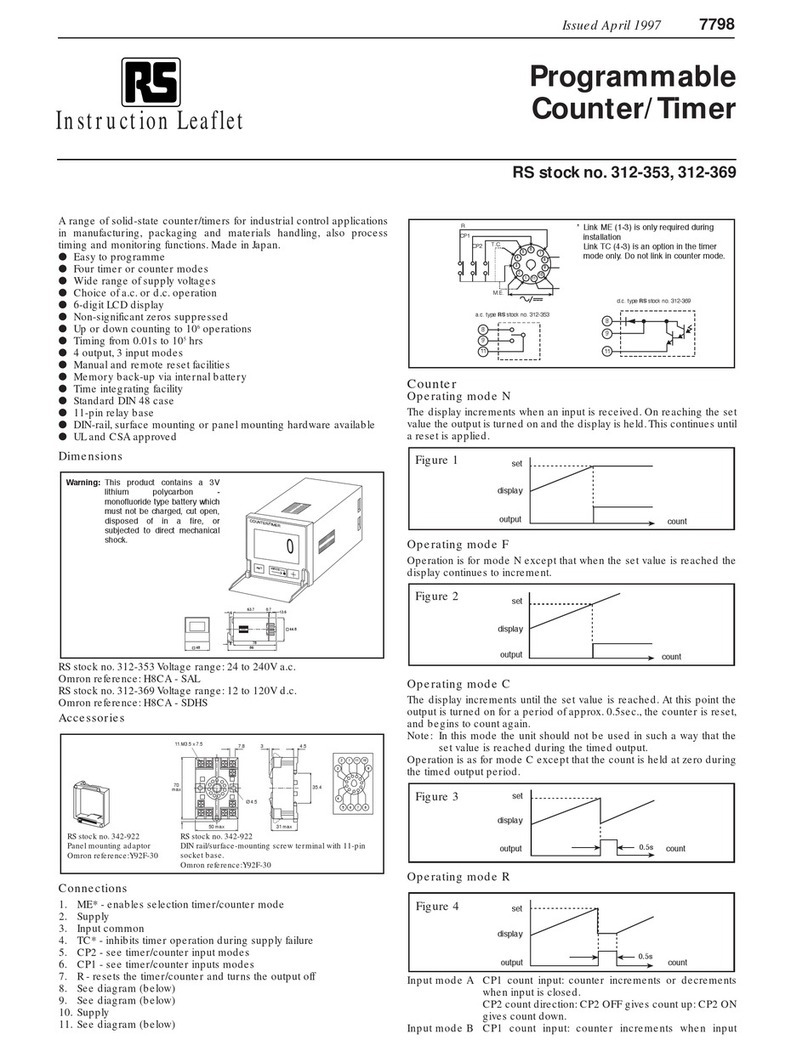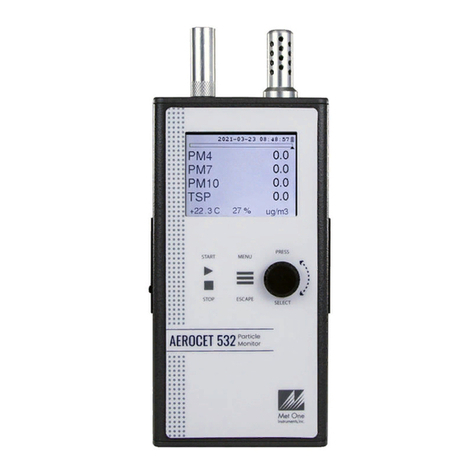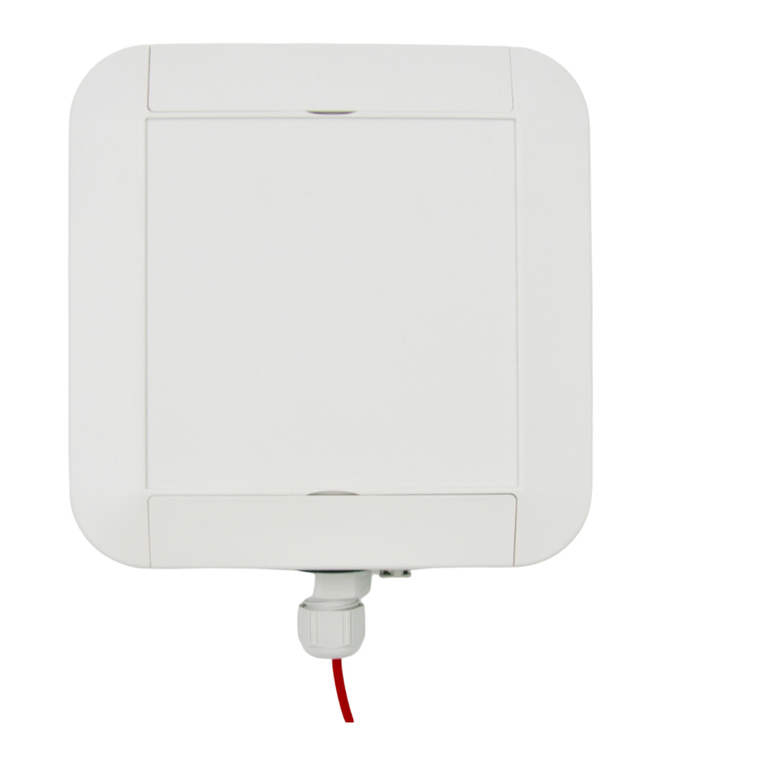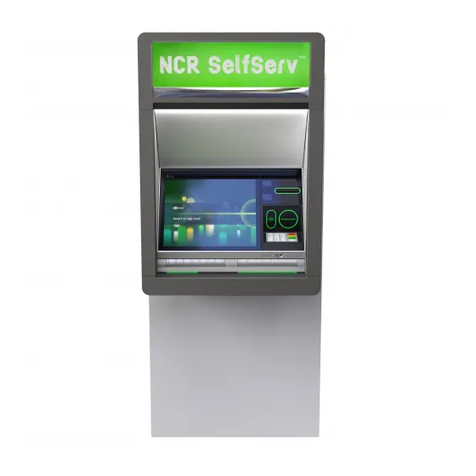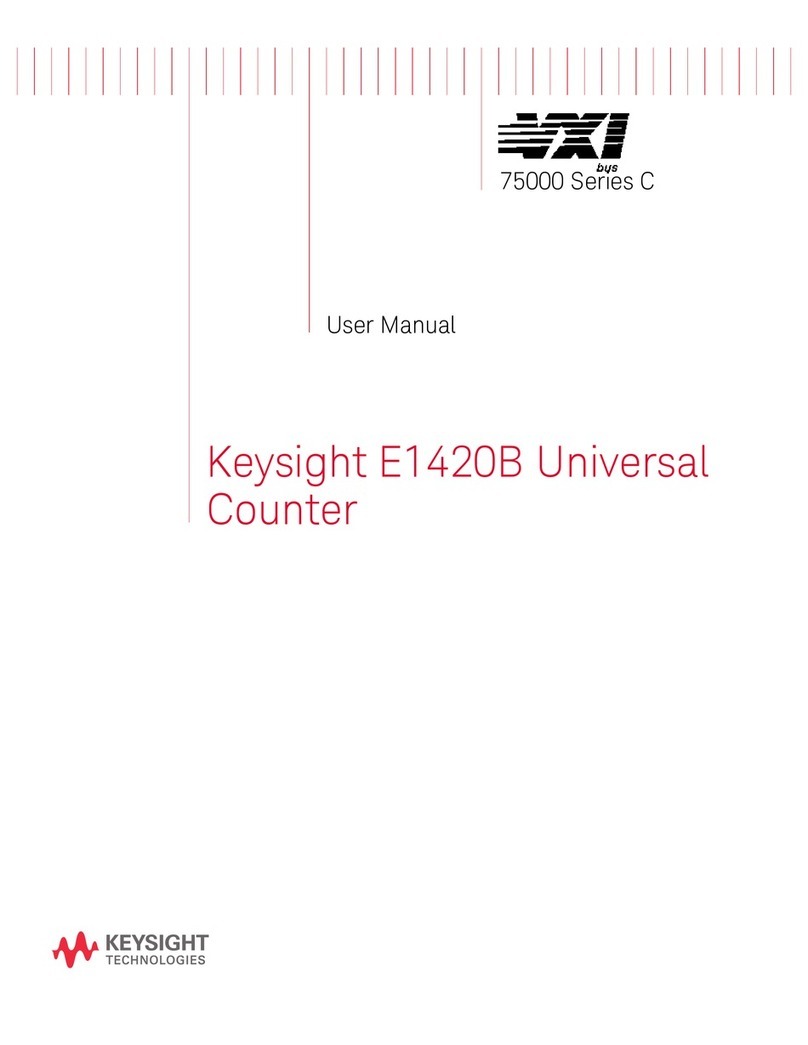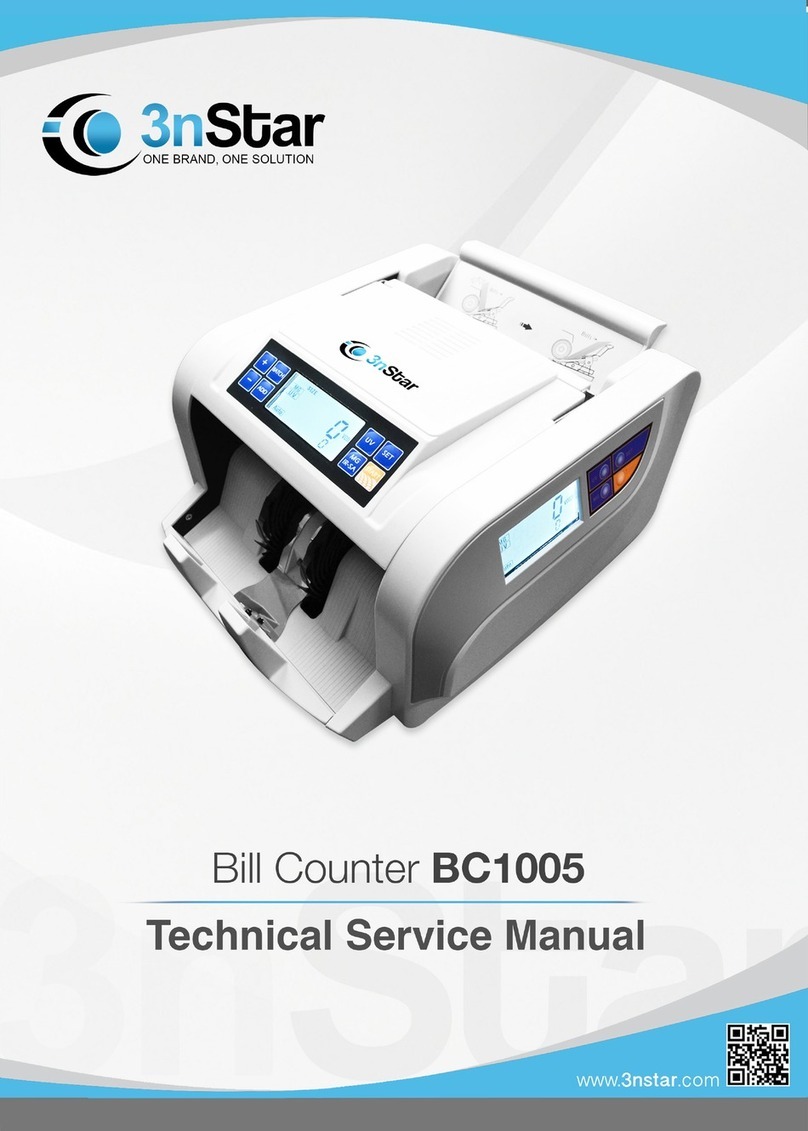WIKA 4 User manual

Example: Model 432.50.100 per ATEX
EN
DE
Operating instructions
Betriebsanleitung
Pressure gauge model 4, NS100 and NS160 per ATEX
Manometer Typ 4, NG100 und NG160 nach ATEX

2WIKA operating instructions pressure gauge, model 4 per ATEX
2080276.09 12/2020 EN/DE
EN
DE
Operating instructions model 4 per ATEX Page 3 - 16
Betriebsanleitung Typ 4 nach ATEX Seite 17 - 30
© 12/2003 WIKA Alexander Wiegand SE & Co. KG
All rights reserved.
WIKA®is a registered trademark in various countries.
WIKA®ist eine geschützte Marke in verschiedenen Ländern.
Prior to starting any work, read the operating instructions!
Keep for later use!
Vor Beginn aller Arbeiten Betriebsanleitung lesen!
Zum späteren Gebrauch aufbewahren!

3WIKA operating instructions pressure gauge, model 4 per ATEX
2080276.09 12/2020 EN/DE
EN
Contents
Contents
Declarations of conformity can be found online at www.wika.com.
1. General information 4
2. Safety 5
2.1 Intended use . . . . . . . . . . . . . . . . . . . . . . 5
2.2 Responsibility of the operator . . . . . . . . . . . . . . . . 5
2.3 Personnel qualification. . . . . . . . . . . . . . . . . . . 6
2.4 Specifications and temperature limits. . . . . . . . . . . . . . 7
2.5 Special hazards . . . . . . . . . . . . . . . . . . . . . 8
2.6 Labelling / Safety marks . . . . . . . . . . . . . . . . . . 9
2.7 Special conditions for safe use (X conditions) . . . . . . . . . . .10
3. Specications 10
4. Design and function 11
5. Transport, packaging and storage 11
5.1 Transport . . . . . . . . . . . . . . . . . . . . . . .11
5.2 Packaging . . . . . . . . . . . . . . . . . . . . . . .11
5.3 Storage . . . . . . . . . . . . . . . . . . . . . . . .11
6. Commissioning, operation 12
6.1 Mechanical connection . . . . . . . . . . . . . . . . . .12
6.2 Commissioning . . . . . . . . . . . . . . . . . . . . .14
7. Maintenance and cleaning 14
7.1 Maintenance . . . . . . . . . . . . . . . . . . . . . .14
7.2 Cleaning . . . . . . . . . . . . . . . . . . . . . . .14
8. Dismounting and disposal 15
8.1 Dismounting . . . . . . . . . . . . . . . . . . . . . .15
8.2 Disposal . . . . . . . . . . . . . . . . . . . . . . .15
Annex: EU declaration of conformity 16

WIKA operating instructions pressure gauge, model 4 per ATEX4
2080276.09 12/2020 EN/DE
EN
1. General information
1. General information
The instrument described in the operating instructions has been designed and manufac-
tured using state-of-the-art technology. All components are subject to stringent quality
and environmental criteria during production. Our management systems are certied to
ISO 9001 and ISO 14001.
These operating instructions contain important information on handling the instrument.
Working safely requires that all safety instructions and work instructions are observed.
Observe the relevant local accident prevention regulations and general safety regulations
for the instrument's range of use.
The operating instructions are part of the product and must be kept in the immediate
vicinity of the instrument and readily accessible to skilled personnel at any time.
Skilled personnel must have carefully read and understood the operating instructions
prior to beginning any work.
The manufacturer's liability is void in the case of any damage caused by using the
product contrary to its intended use, non-compliance with these operating instructions,
assignment of insuciently qualied skilled personnel or unauthorised modications to
the instrument.
The general terms and conditions contained in the sales documentation shall apply.
Subject to technical modications.
Further information:
- Internet address: www.wika.de / www.wika.com
Model Data sheet
432.50, 433.50, 432.30, 433.30,
452.50, 453.50, 452.30, 453.30
PM 04.03
432.56, 433.56, 432.36, 433.36,
452.56, 453.56, 452.36, 453.36
PM 04.07
Explanation of symbols
WARNING!
... indicates a potentially dangerous situation that can result in serious injury
or death, if not avoided.
Information
... points out useful tips, recommendations and information for ecient and
trouble-free operation.
WARNING!
... indicates a potentially dangerous situation in the hazardous area that
results in serious injury or death, if not avoided.

5WIKA operating instructions pressure gauge, model 4 per ATEX
2080276.09 12/2020 EN/DE
EN
2. Safety
2. Safety
WARNING!
Before installation, commissioning and operation, ensure that the appropriate
instrument has been selected in terms of measuring range, design and
specic measuring conditions.
Check the compatibility with the medium of the materials subjected to
pressure!
In order to guarantee the measurement accuracy and long-term stability
specied, the corresponding load limits must be observed.
▶
Non-observance can result in serious injury and/or damage to property.
Further important safety instructions can be found in the individual chapters of
these operating instructions.
2.1 Intended use
These pressure gauges are used for measuring pressure in hazardous areas of industrial
applications.
The instrument has been designed and built solely for the intended use described here, and
may only be used accordingly.
The manufacturer shall not be liable for claims of any type based on operation contrary to
the intended use.
2.2 Responsibility of the operator
The legibility of the marking must be observed during time in use but at least during
inspection periods of three years. If any harm of the legibility is found please contact the
manufacturer to renew the marking.
For the safety of the system, the operator is obliged to carry out an ignition source analy-
sis. The responsibility for classication of zones lies with the plant manager and not the
manufacturer/supplier of the equipment.
These ignition sources must be taken into account for the instrument:
1. Hot surfaces
The surface of the instrument can heat up due to the temperature of the process
medium.This depends on the installation situation and must be taken into account by
the operator.
2. Mechanically generated sparks
Mechanically generated sparks are a potential ignition source. If the materials used
exceed a total mass percentage of 7.5 % magnesium, titanium and zirconium, the opera-
tor must take appropriate protective measures.

WIKA operating instructions pressure gauge, model 4 per ATEX6
2080276.09 12/2020 EN/DE
EN
3. Static electricity
- To avoid electrostatic charging, the instrument must be included in the equipotential
bonding of the system.This can be done via the process connection or other suitable
measures.
- The instrument can optionally contain components with a non-conductive surface
coating or lining. In such cases, the operator must take appropriate measures to
prevent electrostatic charging.
- Metal components of the instruments (e.g.TAG plates) must be included in the equipo-
tential bonding of the system during installation and operation.
4. Adiabatic compression and shock waves
With gaseous media, the temperature may increase as a result of compression warming.
In these cases it may be necessary to throttle the rate of change of pressure or reduce
the permissible medium temperature.
5. Chemical reactions
The operator must ensure that chemical reactions between wetted parts, process
medium and environment are excluded. The materials used can be found in the instru-
ment marking. See chapter “2.6 Labelling / Safety marks”.
On the wetted parts of the instrument, small residual amounts of the adjust-
ment medium (e.g. compressed air, water, oil) can adhere from production.
With increased requirements for technical cleanliness, suitability for the appli-
cation must be checked by the operator before commissioning.
Liquid media with the property of changing the volume during solidication
can damage the measuring system (e.g. water if it falls below the freezing
point).
2.3 Personnel qualification
WARNING!
Riskofinjuryshouldqualicationbeinsucient!
Improper handling can result in considerable injury and damage to property.
▶
The activities described in these operating instructions may only be carried
out by skilled personnel who have the qualications described below.
Skilled personnel
Skilled personnel are understood to be personnel who, based on their technical training,
knowledge of measurement and control technology and on their experience and knowledge
of country-specic regulations, current standards and directives, are capable of carrying out
the work described and independently recognising potential hazards.
2. Safety

7WIKA operating instructions pressure gauge, model 4 per ATEX
2080276.09 12/2020 EN/DE
EN
2. Safety
Special knowledge for working with instruments for hazardous areas:
The skilled personnel must have knowledge of ignition protection types, regulations and
provisions for equipment in hazardous areas.
2.4 Specifications and temperature limits
WARNING!
Non-observance of these instructions and their contents may result in the loss
of explosion protection.
WARNING!
It is imperative that the application conditions and safety requirements are
followed.
▶
Instruments must be grounded via the process connection.
Permissible ambient temperature
-20 ... +60 °C
-40 ... +60 °C (optional, only with silicone oil lling)
Permissible medium temperature
-20 ... +100 °C
-20 ... +200 °C (optional, unlled instruments or with silicone oil lling)
-40 ... +100 °C (optional, only with silicone oil lling)
-40 ... +200 °C (optional, only with silicone oil lling)
The permissible medium temperature does not only depend on the instrument design, but
also on the ignition temperature of the surrounding gases, vapours or dusts. Both aspects
have to be taken into account.
Maximum surface temperature
The surface temperature of the instruments mainly depends on the medium temperature of
the application.The instrument itself does not contain any heat sources.
For determining the maximum surface temperature, besides the medium temperature also
other inuences such as the ambient temperature and, if applicable, the solar irradiation
must be taken into account. For prevention, consider the maximum medium temperature as
maximum surface temperature, if it is not possible to determine the real surface temperature
even in the case of expected malfunctions.
Potentially explosive gas atmosphere
Required temperature class
(ignition temperature of gas
or vapour)
Maximum permissible surface temperature of the
instrument (for the end application)
unlledorwithsili-
coneoillling
lledinstruments
(except for silicone oil)
T6 (T > 85 °C) +65 °C +65 °C
T5 (T > 100 °C) +80 °C +80 °C

WIKA operating instructions pressure gauge, model 4 per ATEX8
2080276.09 12/2020 EN/DE
EN
Required temperature class
(ignition temperature of gas
or vapour)
Maximum permissible surface temperature of the
instrument (for the end application)
unlledorwithsili-
coneoillling
lledinstruments
(except for silicone oil)
T4 (T > 135 °C) +105 °C +100 °C
T3 (T > 200 °C) +160 °C +100 °C
T2 (T > 300 °C) +200 °C +100 °C
T1 (T > 450 °C) +200 °C +100 °C
Explosive dust atmosphere
For dusts, the procedure specied in ISO/IEC 80079-20-2 for determining the ignition
temperature has to be applied.The ignition temperature is determined separately for dust
clouds and dust layers, respectively. For dust layers, the ignition temperature depends on the
dust layer thickness per IEC/EN 60079-14.
Ignition temperature of
dust
Maximum permissible surface temperature of the instru-
ment (for the end application)
Dust cloud: Tcloud < 2/3 Tcloud
Dust layer: Tlayer < Tlayer − 75 K − (reduction depending on the layer thickness)
The medium temperature must not exceed the lowest determined value for the maximum
permissible surface temperature, even in case of a malfunction.
Explosive atmosphere consisting of hybrid mixtures
The instruments must not be used in areas in which an atmosphere consisting of explosive
hybrid mixtures (dusts mixed with gases) can occur.
2.5 Special hazards
WARNING!
For hazardous media such as oxygen, acetylene, ammable or toxic gases or
liquids, and refrigeration plants, compressors, etc., in addition to all stand-
ard regulations, the appropriate existing codes or regulations must also be
followed.
Instruments with PTFE lining
WARNING!
Media which can become electrostatically charged are not permissible for
instruments with PTFE lining.
▶
Select media that do not generate any electrostatic charge.
For additional important safety instructions see chapter “2.4 Specications and temperature
limits”.
2. Safety

9WIKA operating instructions pressure gauge, model 4 per ATEX
2080276.09 12/2020 EN/DE
EN
WARNING!
Residual media in dismounted instruments can result in a risk to persons, the
environment and equipment.
▶
Take sucient precautionary measures.
2.6 Labelling / Safety marks
Dial
ATEX marking:
II 2G c IIC TX X
II 2D c TX X
Serial number
The legibility of the marking must be observed during time in use but at least during inspec-
tion periods of three years. If any harm of the legibility is found please contact the manufac-
turer to renew the marking.
Product label
Model
Article number
Permissible ambient temperature
Date of manufacture (month/year)
Before mounting and commissioning the instrument, ensure you
read the operating instructions!
The instrument bearing this mark is a safety pressure gauge with a solid bae
wall in accordance with EN 837.
2. Safety

WIKA operating instructions pressure gauge, model 4 per ATEX10
2080276.09 12/2020 EN/DE
EN
Additional label for instruments with PTFE lining
For instruments with PTFE lining, measures must be taken in the lining area, if necessary, in
order to exclude electrostatic charging.
2.7 Special conditions for safe use (X conditions)
1. All accessories (e.g. valves or attachment components) must be assessed in combina-
tion with the delivered instruments by the end user.
2. The operator must recognise ignition hazards and take suitable protective measures.
See chapter 2.2 “Responsibility of the operator”.
3. The legibility of the marking must be observed during time in use but at least during
inspection periods of three years. See chapter 2.2 “Responsibility of the operator”.
4. For instruments with marking pointer, ensure that there are no electrostatic charging
mechanisms at the marking pointer.
5. Avoid any kind of external impact. External impacts can generate sparks through friction
processes between dierent materials.
6. The lling/relling of instruments by non-authorised personnel leads to a loss of the
explosion protection and can lead to damage to the instrument.
3. Specifications
Pressure limitation
Models 432.50, 433.50, 432.30, 433.30, 452.50, 453.50, 452.30, 453.30:
Steady: Full scale value
Fluctuating: 0.9 x full scale value
Short time: 5 x full scale value, however max. 40 bar
Models 432.56, 433.56, 432.36, 433.36, 452.56, 453.56, 452.36, 453.36:
Steady: Full scale value
Fluctuating: 0.9 x full scale value
Short time: 40, 100 or 400 bar
Temperatureeect
When the temperature of the measuring system deviates from the reference
temperature (+20 °C):
max. ±0.8 %/10 K of full scale value
2.Safety/3.Specications

11WIKA operating instructions pressure gauge, model 4 per ATEX
2080276.09 12/2020 EN/DE
EN
4. Design and function / 5. Transport, packaging
Case ingress protection 1) (per IEC/EN 60529)
IP54 (with liquid lling IP65)
For further specications see WIKA data sheet PM 04.03, PM 04.07 and the order
documentation.
1) For general use, no ATEX requirement
4. Design and function
Description
Nominal size 100 or 160 mm
The instruments measure the pressure by means of resilient diaphragm pressure
elements.
The measuring characteristics are in accordance with the EN 837-3 standard.
With models 432.50, 433.50, 452.50, 453.50, 432.56, 433.56, 452.56, 453.56 the case
is equipped with a blow-out device in the case back and therefore meets the safety level
“S1” per EN 837-1.
With models 432.30, 433.30, 452.30, 453.30, 432.36, 433.36, 452.36, 453.36 the case
is equipped with a solid bae wall (Solidfront) and a blow-out back and therefore meets
the safety level “S3” per EN 837-1.
Scope of delivery
Cross-check scope of delivery with delivery note.
5. Transport, packaging and storage
5.1 Transport
Check the instrument for any damage that may have been caused by transport. Obvious
damage must be reported immediately.
Shocks can cause small bubbles to form in the ll uid of lled instruments.
This has no eect on the function of the instrument.
5.2 Packaging
Do not remove packaging until just before mounting.
Keep the packaging as it will provide optimum protection during transport (e.g. change in
installation site, sending for repair).
5.3 Storage
Permissible storage temperature
-20 ... +70 °C (optional: -40 … +70 °C)

WIKA operating instructions pressure gauge, model 4 per ATEX12
2080276.09 12/2020 EN/DE
EN
6. Commissioning, operation
6.1 Mechanical connection
In accordance with the general technical regulations for pressure gauges (e.g. EN 837-2
“Selection and installation recommendations for pressure gauges”).
Instruments must be grounded via the process connection.
This is why electrically conductive sealing should be used at the process connection.
Alternatively, take other measures for grounding.When screwing the instruments in, the force
required for sealing must not be applied through the case, but only through the spanner ats
provided for this purpose, and using a suitable tool.
For parallel threads, use at gaskets, lens-type sealing rings or WIKA prole sealings at the
sealing face .With tapered threads (e.g. NPT threads), sealing is made in the threads ,
using a suitable sealing material (EN 837-2).
The tightening torque depends on the sealing used. In order to orientate the measuring
instrument so that it can be read as well as possible, a connection with LH-RH union or
union nut should be used. When a blow-out device is tted to a instrument, it must be
protected against being blocked by debris and dirt.
Requirements for the installation point
If the line to the measuring instrument is not adequately stable, an instrument mounting
bracket should be used for fastening. If vibrations cannot be avoided by means of suitable
installation, instruments with liquid lling should be used. The instruments should be
protected against coarse dirt and wide uctuations in ambient temperature.
Installation
Nominal position per EN 837-3 / 9.6.6 image 7: 90° ( ⊥), if not stated otherwise in the
order documentation.
Process connection lower mount
Installation with
open-ended
spanner
Flange connection 1)
1) The screw connection of the ange must
not be opened
Sealing in the
thread
Spanner ats
Sealing face
6. Commissioning, operation

13WIKA operating instructions pressure gauge, model 4 per ATEX
2080276.09 12/2020 EN/DE
EN
For lled versions, it must be ensured that a case lling which escapes in the event of
a fault cannot reach system parts whose surface temperature exceeds the maximum
permissible medium temperature of the instrument.
For outdoor applications, the selected installation location has to be suitable for the
specied ingress protection, so that the instrument is not exposed to impermissible
weather conditions.
In order to avoid any additional heating, the instruments must not be exposed to direct
solar irradiation while in operation!
To ensure that the pressure can be safely vented in the case of failure, instruments with
blow-out device or blow-out back must keep a minimum distance of 20 mm from each
object.
Permissible ambient and operating temperatures
When mounting the instrument it must be ensured that, taking into consideration the inu-
ence of convection and heat radiation, no deviation above or below the permissible ambient
and medium temperatures can occur. The inuence of temperature on the indication accura-
cy must be observed.
WARNING!
The actual maximum surface temperature depends not on the equipment
itself, but mainly on the operating conditions.With gaseous substances, the
temperature may increase as a result of compression warming. In these cases
it may be necessary to throttle the rate of change of pressure or reduce the
permissible medium temperature.
Permissible vibration load at the installation site
The instruments should always be installed in locations free from vibration.
If necessary, it is possible to isolate the instrument from the mounting point, e.g. by installing
a exible connection line between the measuring point and the instrument and mounting the
instrument on a suitable bracket.
If this is not possible, the following limit values must not be exceeded:
Frequency range < 150 Hz
Acceleration < 0.5 g (5 m/s2)
Commissioning of pressure compensating valve
Instruments which are tted with a pressure compensating valve
must, following installation, be vented for internal pressure compen-
sation.
Tool: Open-ended spanner SW 9
1. Remove plastic cap
2. Loosen the threaded connection above the valve body
3. Screw the valve body tight, turned through 180°, with ≤ 4.5 Nm
For information on the ingress protection, see Technical information IN 00.18
After commissioning
Before commissioning
6. Commissioning, operation

WIKA operating instructions pressure gauge, model 4 per ATEX14
2080276.09 12/2020 EN/DE
EN
Level check
For lled instruments, the level must be checked on a regular basis.
The liquid level must not drop below 75 % of the instrument diameter.
6.2 Commissioning
During the commissioning process pressure surges must be avoided at all costs. Open the
shut-o valves slowly.
7. Maintenance and cleaning
7.1 Maintenance
The instruments are maintenance-free. The indicator should be checked once or twice
every year. For this the instrument must be disconnected from the process to check with a
pressure testing device.
WARNING!
Dangertolifeduetoimpermissiblelling/rellingoftheinstrument
with loss of explosion protection
The lling/relling of instruments by non-authorised personnel leads to a loss
of the explosion protection and can lead to damage to the instrument.
▶
Repair of the instruments may only be carried out by authorised bodies.
If the instrument is exposed to intensive UV radiation, the colouring of the dial
printing may change. This has no eect on the function of the instrument.
7.2 Cleaning
CAUTION!
Physical injuries and damage to property and the environment
Improper cleaning may lead to physical injuries and damage to property and
the environment. Residual media in the dismounted instrument can result in a
risk to persons, the environment and equipment.
▶
Carry out the cleaning process as described below.
1. Before cleaning, correctly disconnect the instrument from the pressure
supply.
2. Use the requisite protective equipment.
3. Clean the instrument with a moist cloth.
6. Commissioning, operation / 7. Maintenance and cleaning

15WIKA operating instructions pressure gauge, model 4 per ATEX
2080276.09 12/2020 EN/DE
EN
CAUTION!
Damage to the instrument
Improper cleaning may lead to damage to the instrument!
▶
Do not use any aggressive cleaning agents.
▶
Do not use any hard or pointed objects for cleaning.
4. Wash or clean the dismounted instrument, in order to protect persons and
the environment from exposure to residual media.
8. Dismounting and disposal
WARNING!
Residual media in dismounted instruments can result in a risk to persons, the
environment and equipment.
Take sucient precautionary measures.
8.1 Dismounting
Only disconnect the instrument once the system has been depressurised!
8.2 Disposal
Incorrect disposal can put the environment at risk.
Dispose of instrument components and packaging materials in an environmentally compati-
ble way and in accordance with the country-specic waste disposal regulations.
7. Maintenance and cleaning / 8. Dismounting and disposal

WIKA operating instructions pressure gauge, model 4 per ATEX16
2080276.09 12/2020 EN/DE
EN
Annex: EU declaration of conformity

17WIKA Betriebsanleitung Manometer, Typ 4 nach ATEX
2080276.09 12/2020 EN/DE
DE
Inhalt
Inhalt
Konformitätserklärungen nden Sie online unter www.wika.de.
1. Allgemeines 18
2. Sicherheit 19
2.1 Bestimmungsgemäße Verwendung . . . . . . . . . . . . . .19
2.2 Verantwortung des Betreibers . . . . . . . . . . . . . . . .19
2.3 Personalqualifikation . . . . . . . . . . . . . . . . . . .20
2.4 Spezifikation und Temperaturgrenzen. . . . . . . . . . . . . .21
2.5 Besondere Gefahren . . . . . . . . . . . . . . . . . . .22
2.6 Beschilderung / Sicherheitskennzeichnungen . . . . . . . . . . .23
2.7 Besondere Bedingungen für die sichere Verwendung (X-Conditions) . . .24
3. Technische Daten 24
4. Aufbau und Funktion 25
5. Transport, Verpackung und Lagerung 25
5.1 Transport . . . . . . . . . . . . . . . . . . . . . . .25
5.2 Verpackung . . . . . . . . . . . . . . . . . . . . . .25
5.3 Lagerung . . . . . . . . . . . . . . . . . . . . . . .25
6. Inbetriebnahme, Betrieb 26
6.1 Mechanischer Anschluss . . . . . . . . . . . . . . . . . .26
6.2 Inbetriebnahme . . . . . . . . . . . . . . . . . . . . .28
7. Wartung und Reinigung 28
7.1 Wartung. . . . . . . . . . . . . . . . . . . . . . . .28
7.2 Reinigung . . . . . . . . . . . . . . . . . . . . . . .28
8. Demontage und Entsorgung 29
8.1 Demontage . . . . . . . . . . . . . . . . . . . . . .29
8.2 Entsorgung . . . . . . . . . . . . . . . . . . . . . .29
Anlage: EU-Konformitätserklärung 30

WIKA Betriebsanleitung Manometer, Typ 4 nach ATEX18
2080276.09 12/2020 EN/DE
DE
1. Allgemeines
1. Allgemeines
Das in der Betriebsanleitung beschriebene Gerät wird nach den neuesten Erkenntnissen
konstruiert und gefertigt. Alle Komponenten unterliegen während der Fertigung strengen
Qualitäts- und Umweltkriterien. Unsere Managementsysteme sind nach ISO 9001 und
ISO 14001 zertiziert.
Diese Betriebsanleitung gibt wichtige Hinweise zum Umgang mit dem Gerät. Vorausset-
zung für sicheres Arbeiten ist die Einhaltung aller angegebenen Sicherheitshinweise und
Handlungsanweisungen.
Die für den Einsatzbereich des Gerätes geltenden örtlichen Unfallverhütungsvorschriften
und allgemeinen Sicherheitsbestimmungen einhalten.
Die Betriebsanleitung ist Produktbestandteil und muss in unmittelbarer Nähe des
Gerätes für das Fachpersonal jederzeit zugänglich aufbewahrt werden.
Das Fachpersonal muss die Betriebsanleitung vor Beginn aller Arbeiten sorgfältig durch-
gelesen und verstanden haben.
Die Haftung des Herstellers erlischt bei Schäden durch bestimmungswidrige Verwen-
dung, Nichtbeachten dieser Betriebsanleitung, Einsatz ungenügend qualizierten
Fachpersonals sowie eigenmächtiger Veränderung am Gerät.
Es gelten die allgemeinen Geschäftsbedingungen in den Verkaufsunterlagen.
Technische Änderungen vorbehalten.
Weitere Informationen:
- Internet-Adresse: www.wika.de / www.wika.com
Ty p Datenblatt
432.50, 433.50, 432.30, 433.30,
452.50, 453.50, 452.30, 453.30
PM 04.03
432.56, 433.56, 432.36, 433.36,
452.56, 453.56, 452.36, 453.36
PM 04.07
Symbolerklärung
WARNUNG!
… weist auf eine möglicherweise gefährliche Situation hin, die zum Tod oder
zu schweren Verletzungen führen kann, wenn sie nicht gemieden wird.
Information
… hebt nützliche Tipps und Empfehlungen sowie Informationen für einen
ezienten und störungsfreien Betrieb hervor.
WARNUNG!
… weist auf eine möglicherweise gefährliche Situation im
explosionsgefährdeten Bereich hin, die zum Tod oder zu schweren
Verletzungen führt, wenn sie nicht gemieden wird.

19WIKA Betriebsanleitung Manometer, Typ 4 nach ATEX
2080276.09 12/2020 EN/DE
DE
2. Sicherheit
2. Sicherheit
WARNUNG!
Vor Montage, Inbetriebnahme und Betrieb sicherstellen, dass das richtige
Gerät hinsichtlich Messbereich, Ausführung und spezischen Messbedingun-
gen ausgewählt wurde.
Verträglichkeit der druckbelasteten Werkstoe mit dem Messsto prüfen!
Die Belastungsgrenzen sind einzuhalten, um die Messgenauigkeit und die
Lebensdauer zu gewährleisten.
▶
Bei Nichtbeachten können schwere Körperverletzungen und/oder
Sachschäden auftreten.
Weitere wichtige Sicherheitshinweise benden sich in den einzelnen Kapiteln
dieser Betriebsanleitung.
2.1 Bestimmungsgemäße Verwendung
Diese Manometer dienen zum Messen von Druck bei industriellen Anwendungen in explosi-
onsgefährdeten Bereichen.
Das Gerät ist ausschließlich für den hier beschriebenen bestimmungsgemäßen Verwen-
dungszweck konzipiert und konstruiert und darf nur dementsprechend verwendet werden.
Ansprüche jeglicher Art aufgrund von nicht bestimmungsgemäßer Verwendung sind ausge-
schlossen.
2.2 Verantwortung des Betreibers
Die Lesbarkeit der Kennzeichnung muss während der Dauer der Verwendung, jedoch
mindestens während eines Prüfzeitraums von drei Jahren kontrolliert werden. Sollte die
Lesbarkeit beeinträchtigt sein, den Hersteller bitten, die Kennzeichnung zu erneuern.
Zur Sicherheit der Anlage ist der Betreiber verpichtet eine Zündquellenanalyse durchzufüh-
ren. Die Verantwortung über die Zoneneinteilung unterliegt dem Anlagenbetreiber und nicht
dem Hersteller/Lieferanten der Betriebsmittel.
Diese Zündquellen sind für das Gerät zu berücksichtigen:
1. HeißeOberächen
Durch die Temperatur des Prozessmediums kann sich die Oberäche des Gerätes
erwärmen. Dies ist von der Einbausituation abhängig und muss vom Betreiber berück-
sichtigt werden.
2. Mechanisch erzeugte Funken
Mechanisch erzeugte Funken stellen eine potentielle Zündquelle dar. Sofern die verwen-
deten Werkstoe einen Masseanteil von insgesamt 7,5 % Magnesium, Titan und Zirkon
überschreiten, sind vom Betreiber geeignete Schutzmaßnahmen zu ergreifen.

WIKA Betriebsanleitung Manometer, Typ 4 nach ATEX20
2080276.09 12/2020 EN/DE
DE
3. Statische Elektrizität
- Zur Vermeidung von elektrostatischer Auadung ist das Gerät in den Potentialaus-
gleich der Anlage einzubeziehen. Dies kann über den Prozessanschluss oder über
andere geeignete Maßnahmen erfolgen.
- Das Gerät kann optional Komponenten mit einer nichtleitenden Oberächenbeschich-
tung oder Auskleidung enthalten. In solchen Fällen muss der Betreiber eine elektrosta-
tische Auadung durch geeignete Maßnahmen verhindern.
- Metallische Komponenten der Geräte (z. B.TAG-Schilder) müssen bei der Errichtung
und im Betrieb in den Potentialausgleich der Anlage mit einbezogen werden.
4. Adiabatische Kompression und Stoßwellen
Bei gasförmigen Messstoen kann sich die Temperatur durch Kompressionswärme
erhöhen. In solchen Fällen muss ggf. die Druckänderungsgeschwindigkeit gedrosselt
bzw. die zulässige Messstotemperatur reduziert werden.
5. Chemische Reaktionen
Der Betreiber hat sicherzustellen, dass chemische Reaktionen zwischen messstobe-
rührten Teilen, Prozessmedium und Umgebung ausgeschlossen sind. Die verwendeten
Werkstoe sind der Gerätekennzeichnung zu entnehmen. Siehe Kapitel „2.6 Beschilde-
rung / Sicherheitskennzeichnungen“.
An den messstoberührten Teilen des Gerätes können herstellungsbedingt
geringe Restmengen des Justagemediums (z. B. Druckluft, Wasser, Öl)
anhaften. Bei erhöhten Anforderungen an die technische Sauberkeit muss die
Eignung für den Anwendungsfall vor Inbetriebnahme vom Betreiber geprüft
sein.
Flüssige Messstoe mit der Eigenschaft bei Erstarrung das Volumen zu
verändern können das Messsystem schädigen (z. B.Wasser bei Unterschrei-
ten des Gefrierpunktes).
2.3 Personalqualifikation
WARNUNG!
VerletzungsgefahrbeiunzureichenderQualikation!
Unsachgemäßer Umgang kann zu erheblichen Personen- und Sachschäden
führen.
▶
Die in dieser Betriebsanleitung beschriebenen Tätigkeiten nur durch
Fachpersonal nachfolgend beschriebener Qualikation durchführen
lassen.
Fachpersonal
Das Fachpersonal ist aufgrund seiner fachlichen Ausbildung, seiner Kenntnisse der Mess-
und Regelungstechnik und seiner Erfahrungen sowie Kenntnis der landesspezischen
Vorschriften, geltenden Normen und Richtlinien in der Lage, die beschriebenen Arbeiten
auszuführen und mögliche Gefahren selbstständig zu erkennen.
2. Sicherheit
Other manuals for 4
1
This manual suits for next models
2
Table of contents
Languages:

